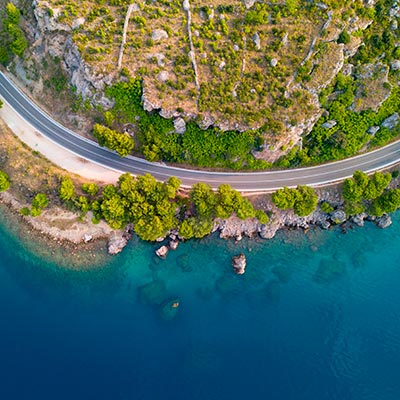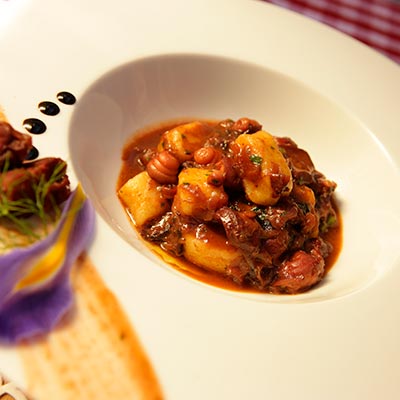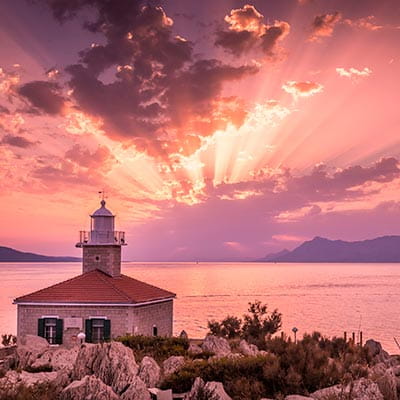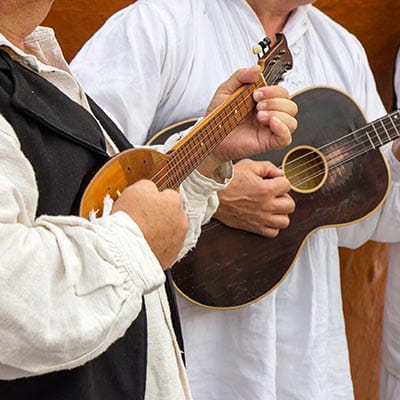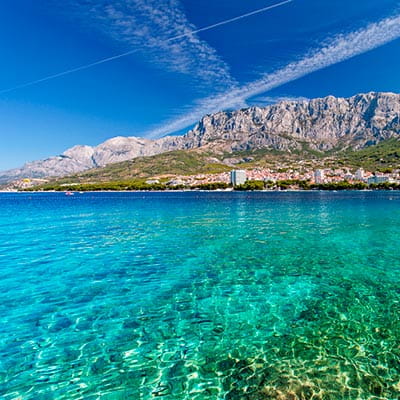Discover the allure of Croatia’s Makarska Riviera with our travel guide
The Makarska Riviera epitomises idyllic getaways in Croatia – baby-blue coastlines, medieval buildings and verdant hillsides, all topped with a generous portion of sunshine. It’s around 60 kilometres in length, running between the towns of Brela, Makarska and Gradac. Asides from the region’s obvious natural beauty, there’s plenty of spiritual and cultural attractions that make a Makarska Riviera holiday one to remember.
Your in-the-know guide to the Makarska Riviera
You’ll soon see that the region’s Dalmatian coastal allures run deep – so you can’t go wrong with a few well-informed pointers as to where’s best to visit and when. Reap the benefits of real insider knowledge of the Makarska Riviera, with advice on where to go, and what to eat and drink, while you’re there. That way, you’ll be all set to soak up the Riviera’s charms.
Bus and boat links make getting around easy, while there is also a wide network of roads if you’d rather hire a car to discover the region.
Getting around by bus
Travelling around Croatia by bus is one of the most cost-effective and efficient ways to discover the Makarska Riviera. Buses to the main towns run frequently, with a journey time of ten minutes costing around 10 HRK.
Getting around by car
You might want to rent your own vehicle rather than use public transport. In which case, just let a member of staff know and they’ll take it from there. Of course, if you’d rather organise it yourself you can. Make sure to take advantage of Saga’s preferential 10% discount rates with Hertz, which comes with a free additional driver.
You can book in advance online through our Hertz discount page, or by calling Hertz on 0870 241 3657 and quoting CDP number 740421. We recommend booking at least 72 hours before your departure. Insurance can be arranged when you hire.
For drives further afield – e.g. through Bosnia and Herzegovina – then you’ll need to ensure that your Green Card covers travelling in these countries.
Also take note that the drink driving laws in Croatia are slightly stricter than the UK, with the blood alcohol limit being 0.5 grams per litre compared to our 0.8. As usual, it’s often safer to avoid alcohol entirely if you’re considering driving.
Useful transport links
Use these links if you want the latest information from Algarve travel providers:
Bus – Buscroatia.com
Car Hire – Hertz 10% Saga discount
Please note that all prices are accurate at time of publishing.
Makarska Riviera – Nature Parks
Biokovo is the second-highest mountain range in Croatia, with the surrounding Biokovo Nature Park being one of the region’s prized attractions. One of the park’s highest points, the Sveti Jure peak, gifts hikers unrivalled views over the mountains and coastline – take your binoculars and keep your eyes peeled for rare mouflon sheep or chamois goat-antelopes. This park runs across most of the Makarska Riviera and is accessible by road.
Makarska – religious sites and museums
Makarska has been occupied by Romans, Turks, French, Venetians and Austrians which has led to a pleasing variety of architectural influences. The Franciscan Monastery was built by Bosnian monks circa 1614. Today, it houses a Malacological Museum in the basement, which is said to hold the world’s largest collection of snails, shells and mussels. There’s also the Baroque style St Mark’s Church, which overlooks Kacic Square.
Located a few minutes’ walk from the town centre, Svetiste Vepric is a remarkable outdoor church and a popular Catholic pilgrimage site. It features a cave with a grotto modelled on the Sanctuary of Our Lady of Lourdes, otherwise known as the Domain. Known as a peaceful spot, the site is popular with both worshippers and secular onlookers alike.
Brac island – natural beauty
You can get to Brac island, whose Zlatni Rat sandspit is an iconic symbol of Croatian tourism, from Makarska via boat, with journey times taking around an hour. As well as beaches, the island is renowned for its hard white stone and is home to a stonemason school. This is situated in the town of Pucisca, and guided tours here can show you the pupils hard at work. Make sure to taste the island’s locally produced vino at the winery in Bol.
Beaches near Brela
Head north towards Brela and visit the Punta Rata beach. This gravelly sunspot overlooks the Adriatic Sea and has been recognised by a number of national publications as one of Croatia’s – and the world’s – finest beaches. You’ll find the Brela Stone – a small pine-topped islet – on the western side of the beach. It’s often the cover of Brela postcards, but why not take your camera and capture its natural beauty yourself?
Krka National Park and waterfalls
The natural trove of Krka National Park is easily reached by bus from Sibenik. Once there, a ferry excursion lets you get up close and personal with the wildlife, which includes reptiles, amphibians and over 18 different species of bat.
For many, though, the true highlight of Krka is its magnificent waterfalls. The most famous is Skradinski buk, an awe-inspiring waterfall network with 17 falls ranging through a height of over 45 metres. Or there’s Roski Slap, with 12 falls over 450 metres high.
Split – history and food
One of Croatia’s many UNESCO World Heritage Sites is in Split – the Old Town is located on the site of the Palace of Diocletian, which was built in the fourth century AD. Even as the town grew in the Middle Ages, much of the Roman structure survives. The Mausoleum of Diocletian himself now lies within the Cathedral of St Domnius, too. Walk along the Peristyle, an open courtyard flanked by graceful columns, and you can easily imagine being back in Roman times.
The many-splendored historical pedigree of Split doesn’t end there either. There’s two authentic Egyptian sphinxes and a statue of Gregory of Nin, the bishop who introduced Croatian language services to the population. It’s thought to be good luck to rub his toe, if you’re partial to tradition.
On top of historical sites, museums and churches, you can also explore the tastes of Split. The Pazar, or Green Market, is a quintessential part of the city’s food culture. Later, head to the seafront promenade Riva, and explore the many cafes, bars and souvenir shops.
Dubrovnik – architecture and history
You likely don’t need much introduction to the medieval beauty of Dubrovnik, but we’d like to share some thoughts on how to explore this iconic city. First, approach it by sea and marvel at the castle that overlooks the harbour. Second, take the two-kilometre circular walking route along the city walls. From 22 metres up, you can get a truly 360-degree view of the city. And thirdly, you should take in Dubrovnik from above.
The cable car to Mount Srd costs around 60 HKR, one-way, and rewards visitors with panoramic views of the city. Try the Panorama restaurant at the cable car station if you want to refuel, sample local wines and drink in the view before heading back down.
Back at city level, look out for sights like St Blaise’s Church, Orlando’s Column, and Sponza Palace. The latter is a Renaissance-era gem which now houses the historic city archives. And of course, if you love Game of Thrones, then the special tour that takes you in the footsteps of fan favourites like Tyrion Lannister is not to be missed.
Dubrovnik – beaches and sea
Banje Beach is Dubrovnik’s premier local beach, located right next to the Old Town. Enjoy the sun and a snack at its café bar or restaurant, or visit the chic Banje Beach Club next door and relax on its elegant white daybeds.
Alternatively, join a guided sea kayak tour to see Dubrovnik from the ocean, and enjoy a private picnic on a nearby island. No kayaking experience is required, and you get a life jacket and packed lunch supplied as standard.
Food
Like much of Dalmatia, food in the Makarska Riviera tends to revolve around stewed meats. A typical local dish is pasticada – marinated and roasted beef, cooked in a rich, red sauce and served with either gnocchi or homemade pasta.
Other regional specialities you’ll more than likely come across include baked lamb, usually served with potatoes and onions. Due to the area’s coastal location, Makarska Riviera holidays are also renowned for seafood. Order some fried calamari with a side of aioli for some real Dalmatian flavours.
Wine
Red wine is popular in the Makarska Riviera and wider Dalmatia. A lot of the time the local offerings will come from the Peljesac peninsula or the island of Hvar. Alternatively, opt for a white blend made from the Posip grape, which is found mostly on the island of Korcula. The wines produced from Posip usually make for a dry taste, with bottles served in many Dalmatian restaurants and bars. Many locals mix white wine with water, come summertime. Although this might seem unusual, it’s a tasty way to stay refreshed in the baking Croatian sun.
Beer and spirits
As you’d expect in an Eastern European country, beer is a tipple of choice for many Croatians. One of the best-known brands is Karlovacko, which you’ll find in lots of bars and restaurants. Alongside that, look out for other national pale lagers like Ozujsko or Pan, which is brewed by Carlsberg’s Croatian branch. For craft beer there’s always Vunetovo, which originates from Hvar island, a boat trip away from Makarska. In terms of spirits, the Makarska Riviera is known for its cherry brandy.
Visiting Makarska Riviera in the summer
It gets hot in the Makarska Riviera come summertime. July can see high temperatures of 34 degrees Celsius, with average recordings around 27 degrees Celsius. Rainfall is rare in the summer, but not unheard of. For summer holidays in the Makarska Riviera, pack cool clothes which you feel comfortable in – think shorts, t-shirts and something a little warmer for cooler evenings. Bring a waterproof on the off chance it rains.
Visiting Makarska Riviera in the spring or autumn
Both spring and autumn tend to be pleasantly cool in the Makarska Riviera. April and October temperatures average at 16 degrees Celsius. As spring progresses into summer, temperatures start to heat up, while conversely the later autumn months get progressively colder. Pack light long sleeved shirts and trousers alongside a jacket which’ll keep you warm when the sun sets. Late autumn is the rainiest season here, so consider bringing a waterproof or umbrella if you plan on visiting then.
Visiting Makarska Riviera in the winter
Winters on the Makarska Riviera are cold, but still warmer than that of the UK. Temperatures average at around five to seven degrees between December, progressively getting warmer throughout February and March. It’s best to pack for a few rainy days if you’re coming here between these months, along with warm, long-sleeved garments to wear underneath a coat. Snow is highly unlikely, so don’t pack your skis just yet!
There aren’t many annual events in the Makarska Riviera, but those which do occur showcase the area’s culture at its best. Here’s the top events for summer getaways here.
Omis Festival of Dalmatia Klapa (July)
First established in 1967, the Festival of Dalmatia Klapa takes place annually in the town of Omis. It sees klapa singing performances, which are characterised by vocal harmonies rarely, if ever, accompanied by instruments. Performances take place outdoors, when many of the local population and tourists gather to listen to this traditional form of singing.
Makarska Cultural Summer (July – September)
The Makarska Cultural Summer runs between July and August, and involves concerts and theatre artists performing in town squares. There’s also carnival-esque parades by the marina, often creating a party atmosphere in the town. During the August leg of the festival, a weekly food-music evening known as Fisherman’s Night allows festivalgoers to taste local seafood catches while enjoying open-air music.

